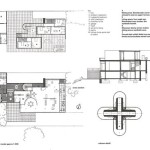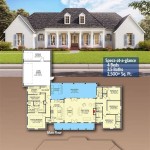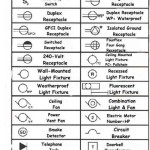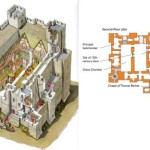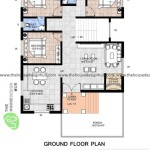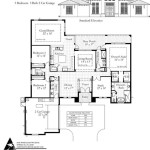Understanding and Utilizing House Floor Plan Pics
House floor plan pictures, or floor plan images, are visual representations of a home's layout from a bird's-eye perspective. They provide a comprehensive overview of the rooms, hallways, and other spaces within a dwelling, indicating their sizes, relationships, and features. These images are essential tools for architects, builders, real estate agents, and homeowners, offering valuable insights into space utilization, design aesthetics, and potential renovations.
Floor plans are typically created using computer-aided design (CAD) software or other architectural drafting tools. They are drafted to scale, meaning that measurements on the plan correspond proportionally to the actual dimensions of the building. This scalability allows users to accurately assess the size and arrangement of rooms and furnishings. Elements like walls, doors, windows, stairs, and built-in features are clearly depicted, enabling a clear understanding of the home's structure.
The effectiveness of a house floor plan picture relies on its clarity and detail. A well-crafted plan includes accurate dimensions, labeled rooms, and symbols representing various fixtures and appliances. The level of detail can vary depending on the purpose of the plan, with some plans focusing on basic layout while others include more intricate details such as electrical outlets, plumbing fixtures, and furniture placement.
Key Point 1: Applications of House Floor Plan Pics
House floor plan pictures have a broad range of applications across various industries and personal projects. They are fundamental to the architectural design process, assisting in the conceptualization and refinement of building layouts. During construction, floor plans serve as a guide for builders, ensuring that the structure is built according to the design specifications. They are also crucial for interior design, helping homeowners and designers plan furniture arrangements and optimize space utilization. In real estate, floor plans are used to market properties, providing potential buyers with a visual understanding of the property's layout and dimensions. These plans can be crucial in helping buyers visualize themselves within the space.
Architects use floor plans to communicate design ideas to clients and contractors. These plans allow for collaborative discussions and modifications before construction begins, minimizing costly errors and ensuring that the final product aligns with the client's vision. By visualizing the space in advance, potential problems with the design, such as awkward room layouts or insufficient storage, can be identified and addressed early in the process.
Builders rely on floor plans to accurately construct the building according to the architectural specifications. The plans provide precise measurements and details, ensuring that walls, doors, windows, and other elements are placed correctly. This accuracy is critical for maintaining structural integrity and ensuring that the building meets building codes and safety regulations. Furthermore, builders use floor plans to coordinate various trades, such as electricians and plumbers, ensuring that their work is integrated seamlessly into the overall design.
Interior designers utilize floor plans to create functional and aesthetically pleasing spaces. By analyzing the layout and dimensions of rooms, designers can plan furniture arrangements, select appropriate finishes, and optimize traffic flow. Floor plans also facilitate the selection of suitable furniture sizes and styles, ensuring that the furniture fits comfortably within the space without overcrowding it. Designers can use floor plan software to create 3D renderings of the space, allowing clients to visualize the finished product before making any purchases.
Real estate agents use floor plans to showcase properties to prospective buyers. The plans provide a visual representation of the property's layout, allowing buyers to understand the size and arrangement of rooms. This visual aid can be particularly helpful for buyers who are unable to physically visit the property. Floor plans can also be included in online listings and marketing materials, attracting more potential buyers and increasing the likelihood of a sale. Some real estate agents also offer interactive floor plans that allow users to virtually tour the property and explore different design options.
Key Point 2: Types of House Floor Plan Pics
There are several types of house floor plan pictures, each serving a specific purpose and offering varying levels of detail. These types include 2D floor plans, 3D floor plans, and interactive floor plans. Understanding the differences between these types allows for choosing the most appropriate plan for a specific application.
2D floor plans are the most common type of floor plan, providing a flat, two-dimensional representation of the building's layout. These plans typically include dimensions, room labels, and symbols representing walls, doors, windows, and fixtures. 2D floor plans are simple to create and easy to understand, making them suitable for a wide range of applications, from architectural design to real estate marketing. While they provide a clear overview of the layout, they lack the depth and visual appeal of 3D floor plans.
3D floor plans offer a more realistic and immersive representation of the building's layout. These plans add depth and perspective to the 2D plan, allowing users to visualize the space in three dimensions. 3D floor plans often include furniture, fixtures, and finishes, providing a more complete picture of the finished space. They are particularly useful for interior design and real estate marketing, as they can help potential buyers or tenants visualize themselves living in the space. Creating 3D floor plans requires specialized software and skills, but the added visual appeal can be well worth the effort.
Interactive floor plans take the visual experience a step further by allowing users to virtually explore the building's layout. These plans often include features such as virtual tours, interactive furniture placement, and the ability to change finishes and colors. Interactive floor plans are particularly useful for real estate marketing, as they can provide potential buyers with a more engaging and informative experience. They can also be used in the design process, allowing clients to experiment with different design options and visualize the results in real time. Interactive floor plans require specialized software and development skills, but they can significantly enhance the user experience.
Beyond these primary types, variations exist based on the level of detail included. For example, a conceptual floor plan might focus on the overall layout and room relationships, while a construction floor plan includes detailed dimensions, construction notes, and specifications for materials and finishes. Similarly, a furniture floor plan might focus specifically on the placement of furniture and fixtures, while a landscape floor plan shows the layout of outdoor spaces such as gardens, patios, and walkways.
Key Point 3: Creating and Interpreting House Floor Plan Pics
Creating and interpreting house floor plan pictures requires an understanding of architectural conventions, drafting techniques, and symbols. Whether creating a plan from scratch or interpreting an existing plan, certain principles and practices should be followed to ensure accuracy and clarity.
To create a floor plan, it is essential to start with accurate measurements of the existing space. These measurements should include the length and width of each room, the height of ceilings, and the location of doors, windows, and other fixed elements. These measurements should be recorded accurately and used to create a scaled drawing of the space. CAD software or architectural drafting tools can be used to create the plan, ensuring that the dimensions are precise and the elements are properly aligned.
When drafting a floor plan, it is important to use standardized symbols to represent various elements, such as walls, doors, windows, stairs, and fixtures. These symbols are universally recognized, ensuring that the plan can be easily understood by architects, builders, and other professionals. Walls are typically represented by thick lines, doors by curved lines indicating the direction of swing, and windows by thin lines with gaps to indicate glass panes. Stairs are represented by a series of parallel lines, with arrows indicating the direction of ascent or descent. Furniture and fixtures are typically represented by simplified shapes that approximate their actual size and shape.
Interpreting a floor plan involves understanding the symbols, dimensions, and labels used in the plan. Dimensions are typically indicated in feet and inches, or in metric units such as meters and centimeters. Room labels identify the purpose of each room, such as living room, bedroom, or kitchen. It is important to pay attention to the scale of the plan, which indicates the relationship between the dimensions on the plan and the actual dimensions of the building. For example, a scale of 1/4 inch = 1 foot means that every 1/4 inch on the plan corresponds to 1 foot in the actual building.
Understanding the orientation of the floor plan is also important. Most floor plans include a north arrow, which indicates the direction of north. This information can be used to determine the orientation of the building in relation to the sun, which can affect the amount of natural light that enters the building. It can also be helpful for planning outdoor spaces, such as gardens and patios.
Finally, it is important to consider the overall layout and flow of the building. A well-designed floor plan should have a logical and functional layout, with rooms arranged in a way that facilitates easy movement and maximizes space utilization. The flow of the building should be intuitive, with clear pathways between rooms and minimal wasted space. A good floor plan should also take into account the needs and preferences of the occupants, providing ample storage, comfortable living spaces, and appropriate separation between public and private areas.

House Plans How To Design Your Home Plan

House Plans How To Design Your Home Plan

Peach Tree House Plan Ranch Floor Designs

House Plan Maywood Sater Design Collection

Small House Design 2024001 Pinoy Eplans Floor Plans

Floor Plans Types Symbols Examples

House Plans How To Design Your Home Plan

How To Draw A Floor Plan Live Home 3d

Small House Design Shd 2024007 Pinoy Eplans One Y Bungalow Plans Floor

House Plan Runaway Bay Sater Design Collection

